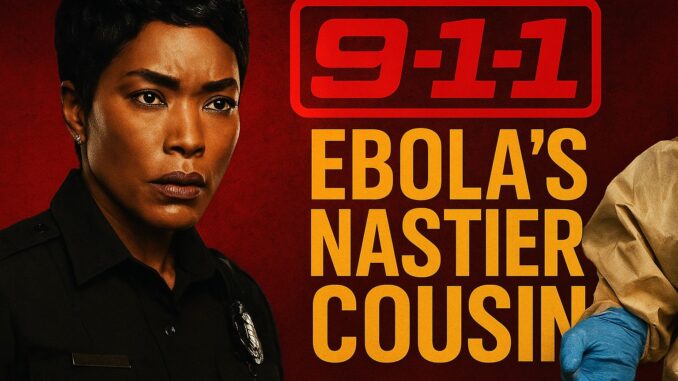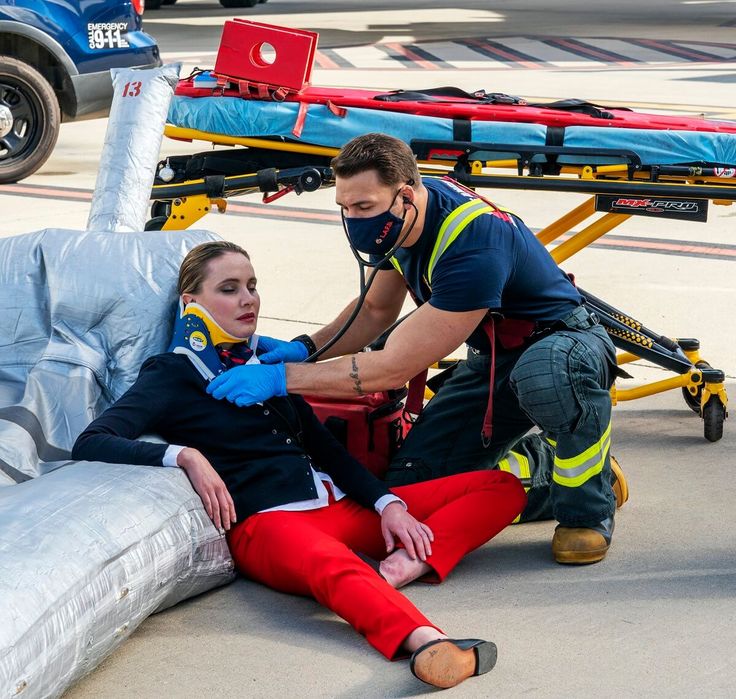
On Thursday’s episode of the ABC first responder drama, station 118 firefighters Bobby (Peter Krause), Hen (Aisha Hinds), and Chimney (Kenneth Choi), Buck (Oliver Stark), and Ravi (Anirudh Pisharody) will answer a fire call at a biomedical research laboratory — and Entertainment Weekly has an exclusive look at their arrival in the clip below. Dispatcher Maddie (Jennifer Love Hewitt) informs the firefighters that the facility’s virology unit runs “tier 4 precautions” — meaning they handle the most deadly of “lethal and exotic viruses.”
The 118 uses duct tape to seal their suits to their gloves and boots and carry gas masks to protect them as they head into the building, which contains, in Hen’s words, “the worst ways to die,” including West Nile and SARS. But the floor on fire (deep below the street level) houses CCHF, or Crimean-Congo hemorrhagic fever, which is described by the World Health Organization as a virus that causes severe viral hemorrhagic fever outbreaks with a case fatality rate up to 40 percent. It’s also described by Hen as “Ebola’s nastier cousin.”
EW’s exclusive clip ends with Bobby taking a badge from the leader of the laboratory and leading his team into the danger. When it comes to high-stakes drama, 9-1-1 has never disappointed. But this time, the first responders are facing a threat unlike anything before—a deadly viral outbreak described as “Ebola’s nastier cousin.” In an exclusive preview, fans see the team gearing up for one of the most harrowing challenges of their careers. This isn’t just another emergency call; it’s a fight against one of the most terrifying killers imaginable.
Why This Episode Stands Out in the 9-1-1 Universe
For years, 9-1-1 has mastered the art of blending adrenaline-pumping emergencies with heart-tugging personal stories. But this particular storyline raises the stakes in a way that feels chillingly real. Pandemics and viral outbreaks aren’t just fiction anymore—they’re nightmares we’ve all lived through. This makes the episode feel both terrifying and eerily familiar.
The Setup: A New Crisis That Pushes Limits
In the upcoming episode, the 118 aren’t battling collapsing buildings, car crashes, or earthquakes. Instead, they’re racing against an invisible enemy—an ultra-lethal virus that spreads faster than anything they’ve encountered before. With lives hanging in the balance, their courage and training are pushed to the extreme.
‘The Worst Ways to Die’: A Phrase That Haunts
The chilling tagline, “the worst ways to die,” isn’t just for shock value. It reflects the brutal reality of the outbreak’s victims. The show doesn’t shy away from showing the grim details, but it does so with sensitivity, balancing fear with hope. For fans, it’s a reminder of just how fragile life can be when nature unleashes its deadliest weapons.
Character Arcs in the Midst of Chaos
Bobby Nash’s Leadership Tested
Captain Bobby Nash, the backbone of the team, faces impossible decisions. Leading during a biological threat isn’t the same as leading during a fire—it’s about containment, risk, and moral choices that could determine who lives or dies.
Athena’s Relentless Drive
As a police officer, Athena finds herself in the middle of enforcing quarantines, dealing with panicked civilians, and keeping her family safe. Her dual role as protector of the public and her loved ones creates some of the episode’s most emotional moments.
Hen and Chimney: The Medical Frontline
Henrietta and Chimney become the closest thing to battlefield medics in this storyline. With their medical training, they carry the heaviest burden—trying to save lives when every second counts and every mistake could mean infection.
The Science Behind the Storyline
While 9-1-1 thrives on dramatization, the writers didn’t invent this virus out of thin air. The “nastier cousin of Ebola” mirrors real-life discussions among virologists about emerging pathogens. These deadly viruses cause hemorrhagic fevers, organ failure, and rapid deterioration. The realism adds weight to the drama, making it both educational and unsettling.
Tapping Into Real-World Fears
Remember the global panic during the COVID-19 pandemic? This episode taps directly into that collective memory. It plays on the fear of invisible threats, the isolation of quarantine, and the desperate hope for survival. The timing couldn’t be more relevant—or more chilling.
Visual Storytelling at Its Peak
The creators of 9-1-1 are known for cinematic visuals, but here they push boundaries. From sterile quarantine zones to frantic emergency scenes, every shot heightens the sense of dread. The makeup and effects used to depict victims of the virus are realistic enough to make viewers shiver.
Why Fans Are Calling It the Darkest Episode Yet
Viewers have always praised 9-1-1 for handling sensitive subjects with respect. Still, fans are already buzzing that this could be the darkest episode in the show’s history. It’s not just about who survives—it’s about how people fight to hold on to humanity when surrounded by death.
The Emotional Toll on the First Responders
What makes this storyline gripping isn’t just the action; it’s the emotional cost. First responders are humans first. They fear for themselves, their families, and their team. The writers weave this tension beautifully, showing vulnerability behind the heroism.
Balancing Fear With Hope
Yes, the virus is terrifying. Yes, people will die. But 9-1-1 never leaves its audience in despair. Just when it feels like the darkness might win, the show reminds us of the resilience of people—of the strength that comes from teamwork, compassion, and courage.
The Bigger Picture: A Social Commentary
Episodes like this aren’t just entertainment. They spark conversations about preparedness, healthcare, and the fragility of our systems. 9-1-1 often mirrors real-world issues, and this episode is a sharp reminder of the lessons we learned—and sometimes forget—from recent history.

What This Means for the Future of the Series
By tackling a storyline this bold, 9-1-1 proves it’s not afraid to evolve. It shows that the series is willing to dive into darker, riskier territory while keeping its emotional core intact. This could mark the beginning of a new chapter in storytelling for the franchise.
Why Viewers Can’t Miss This Episode
If you’ve been waiting for a 9-1-1 episode that combines raw fear, intense drama, and emotional depth, this is it. It’s more than just an emergency-of-the-week—it’s an unforgettable chapter that will leave fans shaken and inspired.
Conclusion
The exclusive preview of 9-1-1’s “Ebola’s nastier cousin” storyline promises one of the show’s most terrifying and thought-provoking episodes yet. By blending heart-pounding emergencies with real-world fears, it pushes viewers to the edge of their seats while reminding us of the courage it takes to face the unknown.
